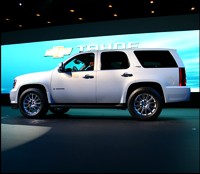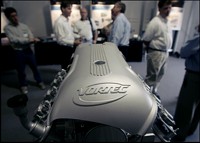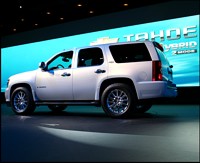The second of the two modes incorporates sophisticated electronic controls, such as active fuel management, cam phasing,
 |
| The second of the two modes incorporates sophisticated electronic controls, such as active fuel management, cam phasing, and late intake valve closure. (Photo: Justin Couture, Canadian Auto Press) |
and late intake valve closure to increase the engine's efficiency when it's working in partnership with the electrical power source or operating independent of it. GM states that the shifts between the two hybrid modes are synchronous, which means no engine speed changes are necessary for the mode shift to occur, resulting in ultra smooth acceleration.
An interesting design aspect of GM's two-mode hybrid system is the integration of powerful compact electric motors engineered to fit within the space allotted a conventional automatic transmission. Both the engine and the electric motors transfer torque to a series of gears inside the Tahoe's sophisticated transmission, which multiplies the incoming torque to propel the heavy vehicle. But unlike more
 |
| Unlike more typical continuously variable transmissions, GM's example uses no mechanical belts or bands to continuously feed torque to the wheels. (Photo: Justin Couture, Canadian Auto Press) |
typical continuously variable transmissions, GM's example uses no mechanical belts or bands to continuously feed torque to the wheels.
Although GM has yet to provide specifications and performance data for the upcoming two-mode full hybrid Tahoe, Mark Cieslak, assistant vehicle chief engineer for the hybrid project had this to say about the vehicle: "We took the brand-new, next-generation full-size truck platform, which already had segment-leading fuel economy and world-class aerodynamics, and took it to the next level. This was in addition to maintaining important performance attributes of full-size trucks, such as off-road capability, towing at 6,000 pounds, great 0-60 times and much more."
I recently joined General Motors in Arizona for the launch of the all-new 2007
 |
| GM's Active Fuel Management technology, previously known as Displacement on Demand, helps its 5.3L V8, the gasoline-powered portion of this hybrid system, to optimize fuel economy even more. (Photo: General Motors of Canada) |
conventionally-powered Tahoe, featuring the brand's 5.3-litre (327 cu-in), 4th generation small-block V8, which will also be used in the upcoming hybrid edition. Chevy placed much emphasis on the efficiency of this mill, which EPA ratings confirm will return 15.6 litres per 100 km and 11.2 litres per 100 km in the city and on the highway respectively. Such class-leading fuel economy is in part attributable to GM's Active Fuel Management technology. Adding the proposed two-mode full hybrid system to this already stingy Vortec V8 is bound to launch it into uncharted fuel-efficiency territory, at least among full-size sport utilities.
Of course, it should be noted that Chrysler Group, which shares in the dual-mode
 |
| By the time the Tahoe Hybrid is available for sale, there will be many full-size hybrid-electric competitors vying for green-minded consumers' attention. (Photo: Justin Couture, Canadian Auto Press) |
fully hybrid technology used by GM in this Tahoe, will be incorporating it into its large SUV lineup, which we have just learned will increase in size thanks to the Durango-based Aspen SUV expected in production trim later this year. Most likely, the Aspen hybrid, and other hybrid versions of Dodge and Jeep models, will arrive around the same time as the fuel efficient Tahoe Hybrid, and also take advantage of cylinder-deactivation technology. Trumping both GM and DaimlerChrysler will most likely be Ford and Toyota, which are expected to develop versions of their full hybrid systems for their larger, V8-powered SUVs. Neither rival currently offers cylinder-deactivation, mind you, but the technology is likely in the works.

